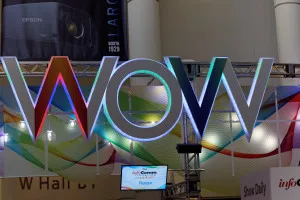Infocomm had a good buzz this year. It was the first Infocomm that this reporter has attended personally for around ten years. The event now sits in second place after ISE in terms of importance in the global A/V industry, which is testament to the work that the ISE team has done. However, Infocomm saw just under 40,000 visitors, with a 5% boost from last year. The event took place in Orlando, which saw very hot weather and some spectacular thunderstorms as visitors were trying to fly out.
The event was preceded by the traditional “Summit” run by Insight Media. This has now been re-branded as the Display Summit, but still has a stronger projection element than many other display industry events and was a real education for me. The event had the real feel of an “insider’s” event of industry specialists talking among themselves. There were some very interesting demos and talks and we have a full report in our issue. Colour, high dynamic range and laser technology were hot topics.
At Infocomm itself, we were struck by some key trends. One trend was for “simplification” and was led by Microsoft and Smart with their collaboration products, but echoed by others. Collaboration software for meeting room displays has been developing for a long time, but now Microsoft and Smart have developed much simpler (to use, at least) software that makes the conferencing experience much more intuitive. I was trying hard to remember when I was ever as impressed by a new Microsoft product that looked so really well thought out in terms of usability. (It doesn’t even use a ‘start’ button to close down!)
The company has always had “new features” and been driven by technology. The new Microsoft Surface Hub really impresses – even competitors identified it as “the product of the show”. It’s expensive, but if it works as well in real life as it did on the show floor (wireless issues excepted and we’ll forgive those), then it will set a new standard for collaboration products. I also was impressed with the Barco Clickshare technology used at the Display Summit. I have used it in meeting rooms before, but hadn’t thought how useful it would be in an event situation.
The second trend was LED. Of course, Samsung’s entry into the direct LED market at CES was bound to invoke a response, and for the last couple of years we have seen tremendous interest in LED at ISE, but there is an absolute stampede of A/V suppliers into direct LED. As the biblical saying goes “many are called, but few are chosen” and that looks as though it will apply in direct LED. Some traditional A/V high end brands will do well out of this trend, but more will find that they get caught between being good (think Barco, Christie, NEC and Samsung as well as traditional LED specialists like Daktronics and Hibino) and the cheap – think Chinese (and some of them are really not bad! Think Absen, Unilumin, Aoto etc.) Clearly large LED is going to be a major display category going forward.
The third trend I picked up was large pro-cap touch. Microsoft’s Surface Hub and Sharp’s 80″ touch panel showed what is possible. At the moment, pricing is a barrier, but that could (and will) change. There could be a big challenge to the suppliers of infrared and optical technologies (although they may have another market in touch-enabling the LED suppliers).
There was lots of innovation and Philips used the Display Summit to launch its ColorSpark technology which has the potential to extend the brightness range of LED projectors into the mainstream of business projection.

